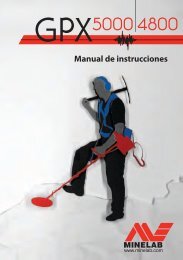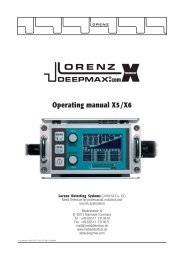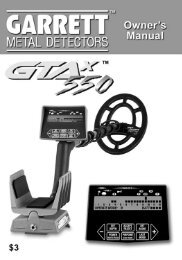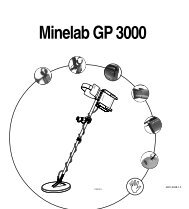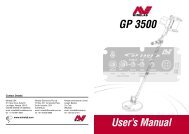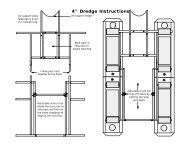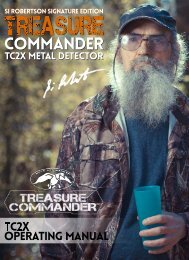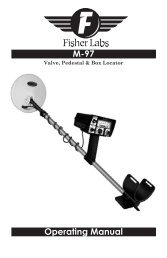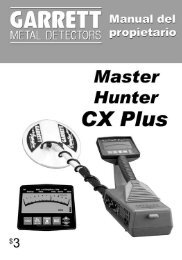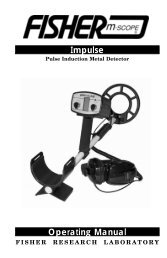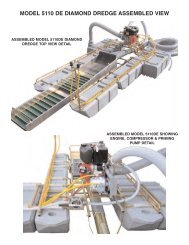OPERATING INSTRUCTIONS: TREASURE ACE 200 - Garrett
OPERATING INSTRUCTIONS: TREASURE ACE 200 - Garrett
OPERATING INSTRUCTIONS: TREASURE ACE 200 - Garrett
You also want an ePaper? Increase the reach of your titles
YUMPU automatically turns print PDFs into web optimized ePapers that Google loves.
<strong>OPERATING</strong> <strong>INSTRUCTIONS</strong>:<strong>TREASURE</strong> <strong>ACE</strong> <strong>200</strong>The Treasure Ace detector is shipped assembled and ready to use. Make sure the first turn ofthe searchcoil cable is over the top of the stem. Adjust the stem length for your height, thenstudy the following.CONTROL FUNCTIONSPower/Detection Depth Control: Rotate knob clockwise to turn detector on. Further rotationincreases detection depth and sensitivity. This control allows you to detect at the greatestdepth possible in relation to conditions that affect the sensitivity of the detector's signals. Turnthe knob slightly to the left when necessary to reduce or eliminate sounds created by groundand/or atmospheric conditions.Trash Elimination: This full-range discrimination control allows you to determine which junkitems you wish eliminated from detection.Headphone Jack: Located on the right side of the control panel. Headphones permit theoperator to hear small and deep targets that might be missed when using audio from thespeaker only.Treasure Eye: An LCD at the top of the control panel which indicates target discovery andaids in the pinpointing of the target. It also monitors the condition of the batteries.Audio: The audio level of the Treasure Ace <strong>200</strong> is factory set to be just into the silent range.Targets will not be missed at this level and there will be no loss of target signals.Battery Test:When the power is turned on, the battery circuit is checked automatically and audibly. As thebatteries begin to discharge the words LOW BATTERY will flash. At first slowly in the lowerleft corner of the LCD. Flashing will become more rapid as battery power is used. When thewords appear constantly, it is time to replace the batteries. The (2) 9-volt batteries are locatedon the backside of the detector housing behind a sliding door. To replace the batteries, slidethe door slightly to the left approximately ½ inch. The door may then be removed to allowaccess to the batteries. Remove the old batteries and replace with high quality carbon,alkaline, or rechargeable batteries. Make certain the new batteries are installed properly,observing polarity. Replace the battery door and slide it closed. Always make certain that allparts fit snugly, but do not force.<strong>OPERATING</strong> <strong>INSTRUCTIONS</strong>:Initial Settings: The Treasure Ace <strong>200</strong> has initial setting points located on the controlpanel. By rotating the knobs to these points the detector is adjusted for normal operation. Asyou become more familiar with the detector you may wish to make slight adjustments in thecontrol settings to suit your personal preferences.
Set the control knobs to the INITIAL SETTING (∆) position. The detector is now operating inthe TRASH ELIMINATION MODE. To operate the TRASH ELIMINATION MODE and eliminate“junk” targets, adjust the Elimination Control to the desired level for foil, nails, bottlecaps, orpulltabs to be eliminated.Scan the searchcoil at about one to two feet per second. Maintain a one or two-inchsearchcoil height above and level to the ground. All accepted metal targets produce an audiosound when the targets are below the coil. Dig all targets that produce an audio signal.TARGET ACCEPTANCE & REJECTIONWhen a metallic object is accepted, the detector’s speaker or headphone sound will increasefrom the factory-set audio threshold level. When a metal object is eliminated (rejected), nosound will be heard. Some rejected targets however, may cause the audio to “break up” orsound erratic. The following explains the various Trash Elimination Settings as shown bythe icons placed around the control knob.Trash Elimination Settings:• In the Trash Range most small rusty iron will be eliminated just above the All-Metal setting.• Salt water is eliminated just below the bottlecap indicator.• At the Bottlecap: foil, nails and larger rusty iron, will be eliminated.• At the Pulltab: pulltabs, bottlecaps, foil, nails and rusty iron will be eliminated.Note: Nickels, rings, and many foreign coins and tokens may also be eliminated at this setting.Test typical trash items before operating.Recovery/Pinpointing:Recovering a target is accomplished first by Pinpointing.Pinpoint targets by drawing an imaginary “X” on the ground with the searchcoil at the placewhere the maximum sound occurs. You will also notice that the Treasure Eye LCD will movefrom the outer edges toward the center. When the cursors meet in the center the target isbeneath the center of the searchcoil and the audio will be at its loudest. You will notice that thesearchcoil cannot be held motionless above the target, the searchcoil must be movingslightly to detect the targets location..The next step in recovery usually involves digging. Always make as small a hole as possible. Itis quicker, requires less digging, and is easier to fill. And, you should always fill your holes.MAINTENANCE Always remember that your metal detector is a sensitive electronic instrument. It is built towithstand rugged treatment in the outdoors. Use your <strong>Garrett</strong> detector to the fullest extentpossible, and never feel that you have to baby it. Yet, always protect the detector andhandle it with reasonable care. Try to avoid temperature extremes as much as possible, such as storing the detector in anautomobile trunk during hot summer months or outdoors in sub-freezing weather.
Keep you detector clean. Always wipe the housing after use, and wash the coil whennecessary. Protect your instrument from dust and sand as much as possible. Your searchcoil is submersible. The control housing is not! Never submerge the controlhousing and always protect it from heavy mist, rain or blowing surf. Disassemble the stem and wipe it clean after use in sandy areas. When storing longer than about one month, remove batteries from the detector.REPAIR SERVICE In case of difficulty, read this Owner’s Manual again thoroughly to make certain yourdetector is not inoperable needlessly. Your dealer may also be able to offer advice. When your detector must be returned to the factory for service, always include a letter thatdescribes its problem as fully as possible. Before you return your detector to the <strong>Garrett</strong>factory, make certain: You have checked batteries, switches and connectors. (Check batteries especially closely.They are the most common cause of detector “failure”.) You have checked with your dealer, particularly if you are not familiar with this type ofdetector. You have included a note with the detector describing the problems you are encounteringwith this detector and conditions under which they occur. Make certain to include yourname, address and a phone number where you can be contacted between 8:30 a.m. and 4p.m., Central Time. You have carefully packed the detector in its original shipping carton or other suitable box.Make certain that proper insulation or packing material is used to keep all parts secure. Donot ship stems or headphones unless they are part of the problem. Be certain to return allcoils. Ship to <strong>Garrett</strong> Metal Detectors, 1881 W. State St., Garland, TX 75042. You can call the <strong>Garrett</strong> Customer Service Department (800-527-4011) if you have furtherquestions. Please allow approximately one week for <strong>Garrett</strong> technicians to examine and repair yourdetector after they receive it, plus another week for return shipping to you. All equipmentwill be returned UPS or parcel post unless written authorization is given by you to shipcollect by air parcel post, UPS Blue (air) or air freight.MIND YOUR MANNERS
Filling holes and obeying no trespassing signs are but two requirements of a dedicated metaldetector hobbyist. A sincere request that Charles <strong>Garrett</strong> makes to every user of one of hisdetectors is that each place searched be left in a better condition than it was found.Thousands of individuals and organizations have adopted this formal Metal Detector OperatorsCode of Ethics: I will respect private and public property, all historical and archaeological sites and will dono metal detecting on these lands without proper permission. I will keep informed on and obey all laws, regulations and rules governing federal, state andlocal public lands. I will aid law enforcement officials whenever possible. I will cause no willful damage to property of any kind, including fence, signs and buildingsand will always fill holes I dig. I will not destroy property, buildings or the remains of ghost towns and other desertedstructures. I will not leave litter or uncovered items lying around. I will carry all trash and dug targetswith me when I leave each search area. I will observe the Golden Rule, using good outdoor manners and conducting myself at alltimes in a manner which will add to the stature and public image of all people engaged inthe field of metal detection.WARNING!Any metal detector may discover underground power lines, explosives or other items whichwhen struck could cause personal injury. When searching for treasure with your detector,observe these precautions: Do not hunt in an area where you believe there may be shallowly buried undergroundelectric lines or pipes. Do not hunt in a military zone where bombs or other explosives may be buried. Avoid striking any line known to be or suspected to be carrying electrical power. Do not disturb any pipeline, particularly if it could be carrying flammable gas or liquid. Use reasonable caution in digging toward any target, particularly in areas where you areuncertain of underground conditions.PATENT PROTECTION: Proof of <strong>Garrett</strong> excellence is the recognition given them by the followingUnited States patents: 4,709,213; 4,488,115; 4,700,139; 4,398,104; 4,423,377; 4,303,879; 4,334,191;
3,662,255; 4,162,969; 4,334,192; 5,148,151; 5,138,262; 5,721,489; 5,786,696; 5,969,528; Design274,704 and 297,221; Design 333,990; G.B. Design 2,011,852; Australia Design 111,674 and otherpatents pending



